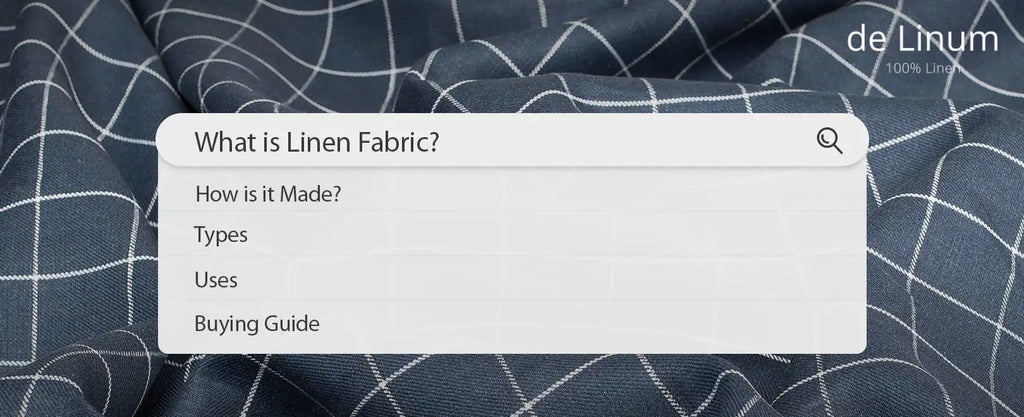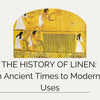What is Linen Fabric: How Is It Made, Types, Uses, Buying Guide

Linen fabric is a beloved textile known for its natural aesthetic, durability and unique properties. It is made from fibres of the flax plant; linen has been used for centuries for a broad range of applications, from clothing to home décor. Linen is also prized for its strength, breathability and hypoallergenic properties, making it a popular choice for summer clothing, towels and bedding.
This article will explore different types of linen fabrics, how they are made, and the many uses of this versatile textile. So continue to read the entire information and know more about linen fabric.
What Is Linen Fabric?
Linen fabric is a particular textile type made using fibres acquired from the flax plant. It is a natural and sustainable material used for thousands of years. One of the features of the fabric is its exceptional durability, moisture-wicking properties and strength, making it a popular choice for bedding, clothing and home décor.
|
Fabric name |
Linen Fabric |
|
Fabric breathability |
Highly breathable |
|
Fabric Weight : GSM |
150 GSM for normal garment 200 GSM for heavier garment |
|
Commonly Used in |
Apparel, Home Décor, Bedding, Industrial Applications |
|
Tensile Strength |
5.5 to 6.5 gm/den |
|
Fabric Colour |
Yellow to grey |
|
Fabric Lustre |
Brighter than cotton and silky |
|
Fabric Elastic Recovery |
Less elastic |
|
Fabric Elongation at Break |
2.7 to 3.5% |
How Is Linen Fabric Made?

Making linen fabric is a fascinating process carried out for years. Here is an insight into the entire process of linen fabric making:
-
Growing and Harvesting of the plant
The plant is grown in cool, damp climates around the world. Once it matures, it is harvested and the seeds are removed.
-
Retting
The stems are soaked in water for several days or weeks until the natural pectins and waxes holding the fibres together break down.
-
Drying
The flax is dried and the fibres are combed and separated from any remaining bits of plant material through scutching.
-
Spinning
At this stage, the flax fibres are spun together into yarn. These yarns are used for weaving linen fabric.
-
Weaving
The process involves interlacing the yarns in a crisscross pattern to create a strong and durable fabric. The loom used for weaving linen fabric is often a simple and traditional design using pedals and hand-operated mechanisms to create the desired pattern.
-
Bleaching
After the fabric is woven, it is often treated with a process called “bleaching,” which involves exposing the fabric to sunlight, water and natural acids to give it a brighter, whiter appearance.
-
Washing and Softening
Finally, the linen fabric is washed and softened using a combination of water, heat and mechanical agitation to make it more comfortable and easier to work with.
Where Does Linen Come From?
Linen is made from the fibre acquired from the flax plant cultivated for thousands of years. It was especially native to the Mediterranean region. However, these are grown worldwide, with the top producers being countries like Russia, France, Belgium and the Netherlands. The fibres of the flax plant are harvested and processed to make linen, a durable, strong and absorbent fabric popular for making a wide variety of home décor, bedding and clothing.
What Colour Is Linen?
Typically, linen is off-white or ivory colour, which is its natural colour. As a natural fabric made from flax fibres, its colour tends to vary. It is usually based on the specific processing and treatment it undergoes. However, linen can also be bleached or dyed to create various colours, including shades of white, grey, brown and even vibrant colours like blue or red.
Moreover, the colour is highly determined by various factors such as the quality of the flax used, the type of soil in which the flax was grown and the specific dye or treatment applied to the fabric.
What Are the Distinct Properties of Linen Fabric?

Linens are known for their distinct properties and characteristics, making it a popular choice for various applications. Some of the properties of linen fabric include:
-
Strength
Linen is a strong and durable fabric that can withstand wear and tear; thus it is ideal for everyday use.
-
Breathability
Linen is highly breathable and allows air to circulate, which helps to keep the wearer cool and comfortable
-
Absorbency
Linen is highly absorbent and can absorb up to 20% of its weight in moisture without feeling damp, making it a popular choice for towels and other items that need to be absorbent.
-
Hypoallergenic
Linen is less likely to cause any type of allergic reactions or irritate sensitive skin.
-
Thermoregulation
Linen has excellent thermoregulatory properties, which means it can help to regulate body temperature and keep the wearer cool in hot weather
-
Anti-static
Linen is resistant to static electricity, which means it does not cling to the body or attract dust and lint.
-
Eco-friendly
Linen fabric is a sustainable and eco-friendly fabric, as it is made from natural fibers and requires less water and chemicals to produce than other fabrics.
What Are the Different Types of Linen Fabrics?
|
Types of Linen by Weaving |
Characteristics |
|
Chambray Linen |
Chambray linen is a lightweight, breathable fabric with a unique texture and appearance that comes from interweaving of coloured and white threads, creating a denim like effect |
|
Sheer Linen |
Sheer linen is a delicate and lightweight fabric with a translucent quality that allows light to filter through, perfect for creating ethereal and elegant garments or window treatments |
|
Types of Linen Fabric by Patterns |
Characteristics |
|
Printed Linen Fabrics |
Printed linen fabric patterns offer a wide range of designs and colour options that can be printed onto the durable and breathable linen fabric, creating a unique and stylish look for clothing, accessories and home decor |
|
Checks & Gingham Linen Fabric |
These fabric patterns offer a classic and timeless appeal with their distinctive crisscross designs and vibrant colour combinations making them a popular choice foe casual clothing, tablecloths and curtains |
|
Plain Linen Fabric |
The pattern showcase the natural beauty and texture of the linen fiber, offering a simple and elegant aesthetic that is versatile and timeless, perfect for a wide range of clothing and home décor applications |
|
Embroidered Linen Fabric |
It showcases intricate and beautiful designs created with thread or yarn, adding texture, depth and personality to the natural beauty of linen, making it a perfect choice for adding a touch of elegance and charm to clothing and home decor |
|
Striped Linen Fabric |
It offers a classic and sophisticated look with their clean and simple lines, creating a versatile and timeless aesthetic that can be used for a wide range of clothing and home décor projects |
|
Floral Linen Fabric |
Delicate and romantic appeal with their intricate and vibrant floral designs adding a touch of femininity and charm to clothing, bedding and home decor |
|
Types of Linen Fabric by Origin |
Characteristics |
|
Irish Linen Fabric |
Irish linen fabric is known for its exceptional quality and durability, with a unique luster and texture that makes it a popular choice luxury clothing and home decor |
|
French Linen Fabric |
It is renowned for its softness, breathability and ability to absorb moisture, making it a popular choice for summer clothing and bedding |
|
Lithuania Linen Fabric |
It is famous for its sturdiness, eco-friendliness and natural texture, making it an ideal choice for a wide range of products, from clothing to home textiles |
|
Italian Linen |
Italian Linen is known for its exquisite craftsmanship, luxurious feel and high-quality materials, making them a favourite among fashion designers and discerning consumers worldwide |
|
Types of Linen Fabric for Different Purposes |
Characteristics |
|
Normal Width Linen |
A normal width for a linen used for clothing purpose ranges between 137 to 150 cm |
|
Extra Wide Linen Fabric |
It is perfect for creating seamless, flowing designs and is popular for curtains, tablecloths and other home décor projects due to its versatility and elegant drape |
|
Upholstery Fabrics |
It is designed to be durable, stain-resistant, able to withstand daily wear and tear, making it a practical and stylish choice for furniture such as chairs, sofas and ottomans |
|
Fat Quarter |
It is a pre-cut piece of quilting fabric that measures 18 inches by 22 inches, making it a versatile and convenient option for small projects and adding variety of quilting designs |
What Are the Uses of Linen Fabric?
Linen fabric is useful for various purposes, from clothing, bedding, upholstery, etc. Here is a gist of its different uses.
For Clothing
Linen fabric is the best choice for clothing due to its
- Breathability
- Strength
- Comfort
- Lustre
- Smoothness
- Commonly used for summer clothing like dresses, shirts and pants.
Check de Linum’s Linen Fabrics here
For Napkins
Linen fabric is most commonly used for home décor fabrics and napkins due to its
- Durability
- Absorbency
- Natural aesthetic
- Shine
- Smoothness
For Table Runner & Tablecloths
Linen fabrics are excellent choices for table runners and tablecloths due to their
- Natural beauty
- Versatility
- Durability
- Hypoallergenic Property
- Absorbent
For Bedding

Linen fabric is best suited for
- Adding natural beauty and comfort
- Regulating body temperature
- Suited for sensitive skin
- Gentle
- Soothing to touch
Check out de Linum’s 100% Pure Linen Bedding - Linen Bed Sheets Collections here
Upholstery

Linen is most commonly used as Upholstery Fabric due to its
- Highly durablity
- Resistant to pilling and tearing
- Linen becomes softer and more comfortable with each use and wash.
- Popular choice for furniture, such as armchairs, ottomans and sofas.
It is resistant to pilling and tearing and becomes softer and more comfortable with each use and wash.
Check out de Linum’s Linen Upholstery Fabrics collection here.
Conclusion
Linen fabric is versatile and durable that has been valued for its natural beauty and practical benefits for thousands of years. de Linum brings you various types of linen fabric in different patterns, design, GSM and more. These are available in various types, including Irish linen, French linen and Lithuanian linen, each with unique characteristics and uses. It can be utilised for a wide range of products, from clothing to home textiles and is particularly popular for items that require durability, such as tablecloths, napkins and upholstery.
Overall, linen fabric remains popular for those who appreciate its timeless beauty, exceptional quality and eco-friendly properties. Visit de Linum website to find more fabric collections.





